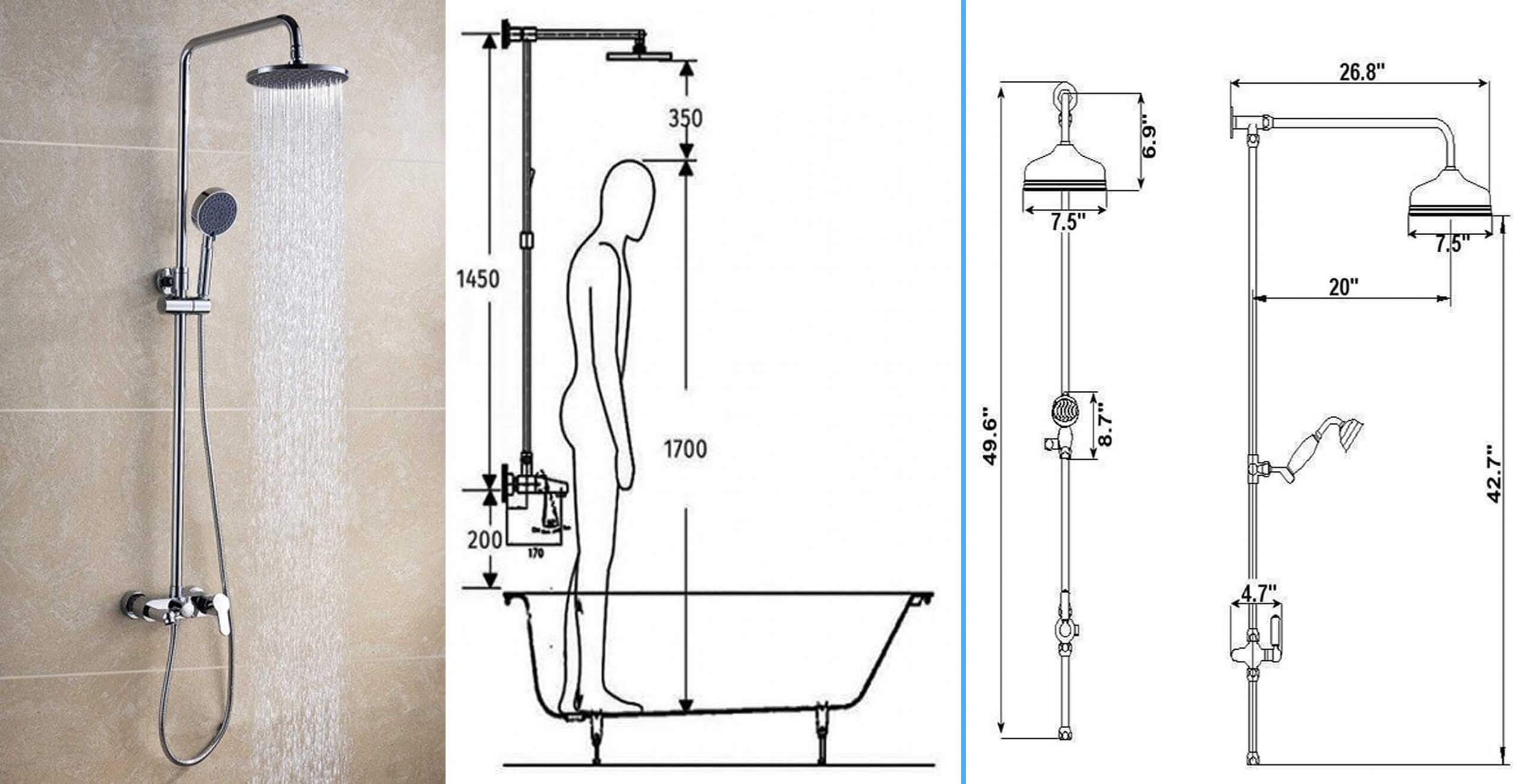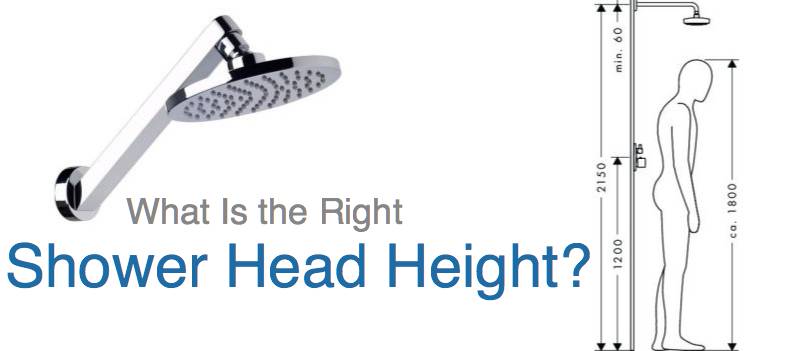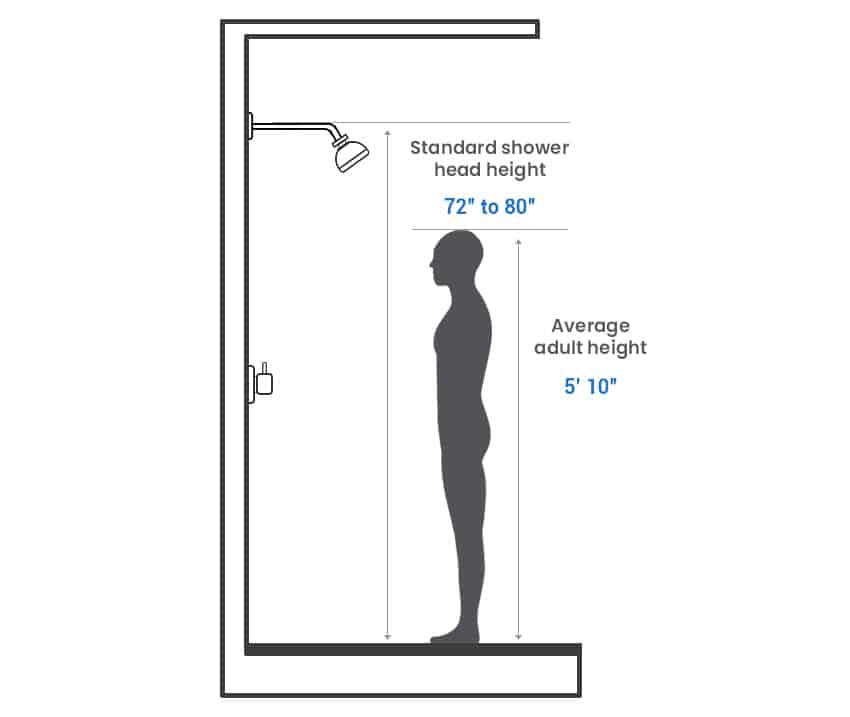Understanding Ideal Shower Head Height: Bathroom Shower Head Height

A shower is a daily ritual for most of us, and a comfortable shower experience hinges on the right shower head height. A poorly positioned shower head can lead to discomfort, inefficient water usage, and even safety hazards. Let’s explore the key factors influencing ideal shower head height and how to achieve a perfect shower experience.
Factors Influencing Ideal Shower Head Height
The ideal shower head height is not a one-size-fits-all solution. Several factors come into play, including:
- User height: Taller individuals naturally require a higher shower head than shorter individuals. A shower head that’s too low for a tall person can lead to a cramped and uncomfortable experience, while a shower head that’s too high for a shorter person might make it difficult to reach and use effectively.
- Shower stall size: A larger shower stall offers more flexibility in terms of shower head placement. In smaller stalls, the shower head height might need to be adjusted to optimize space and functionality. A shower head that’s too high in a small stall might hit the ceiling or make it difficult to move around comfortably.
- Personal preferences: Ultimately, the ideal shower head height is a matter of personal preference. Some people prefer a more focused spray directly on their head, while others might prefer a wider spray that covers a larger area. These preferences can influence the desired shower head height.
Standard Shower Head Heights
A standard shower head height is often recommended based on average user height and accessibility considerations. A general guideline is to position the shower head between 78 and 84 inches from the floor. This range ensures that the shower head is accessible for most people, regardless of their height.
Recommended Shower Head Heights for Various User Heights and Shower Stall Sizes
The following table provides a more detailed guide to recommended shower head heights based on user height and shower stall size:
| User Height | Small Stall (36″ x 36″) | Medium Stall (48″ x 48″) | Large Stall (60″ x 60″) |
|---|---|---|---|
| 5’0″ – 5’4″ | 72″ – 76″ | 76″ – 80″ | 78″ – 82″ |
| 5’5″ – 5’9″ | 74″ – 78″ | 78″ – 82″ | 80″ – 84″ |
| 6’0″ – 6’4″ | 76″ – 80″ | 80″ – 84″ | 82″ – 86″ |
| 6’5″ and above | 78″ – 82″ | 82″ – 86″ | 84″ – 88″ |
Real-Life Examples of Shower Head Height Impact
Imagine a 6’4″ individual showering in a small stall with a shower head positioned at 72 inches. The shower head would be too low, making it difficult to rinse their hair effectively and potentially leading to discomfort. On the other hand, a 5’4″ individual in a large stall with a shower head at 84 inches might struggle to reach the shower head comfortably.
Factors Affecting Shower Head Height

The ideal shower head height is not a one-size-fits-all solution. Several factors play a crucial role in determining the most comfortable and effective height for your shower.
Shower Head Type
The type of shower head you choose significantly impacts the ideal height.
- Fixed shower heads, which are mounted directly to the wall, are best installed at a height that allows the water to comfortably reach your head and shoulders. This typically ranges from 70 to 80 inches above the floor.
- Handheld shower heads offer greater flexibility and allow you to adjust the water stream to different angles and heights. They are often installed at a lower height, around 60 to 70 inches, to facilitate easy handling.
- Rain shower heads, known for their wide, gentle spray, are typically mounted higher, around 80 to 90 inches, to create a more immersive showering experience.
Water Pressure and Flow Rate
Water pressure and flow rate significantly influence the optimal shower head height.
- Higher water pressure allows for a more powerful spray, making it possible to install the shower head at a slightly higher height.
- Lower water pressure requires a lower shower head height to ensure adequate water coverage.
- High flow rate can create a more intense showering experience, but it may also require a higher shower head height to avoid splashing.
- Low flow rate may necessitate a lower shower head height to compensate for the reduced water volume.
Advantages and Disadvantages of Different Heights
Installing a shower head at different heights offers distinct advantages and disadvantages.
- Higher shower head heights provide a more immersive showering experience, allowing for a wider spray pattern and reducing the risk of splashing. However, they may be less comfortable for shorter individuals and can increase the risk of water hitting the ceiling.
- Lower shower head heights are more comfortable for shorter individuals and reduce the risk of water hitting the ceiling. However, they may limit the spray pattern and increase the risk of splashing.
Ceiling Height and Shower Stall Design
The ceiling height and shower stall design also influence the optimal shower head height.
- Higher ceilings allow for greater flexibility in shower head height, while lower ceilings may necessitate a lower installation height.
- Small shower stalls may require a lower shower head height to avoid hitting the walls, while larger stalls offer more flexibility in height.
Visual Representation
Imagine a diagram with a vertical axis representing shower head height and a horizontal axis representing water pressure and flow rate.
- A curved line would represent the relationship between shower head height and water pressure, with higher water pressure allowing for a higher shower head height.
- Another curved line would represent the relationship between shower head height and flow rate, with higher flow rates generally requiring a higher shower head height.
- The ideal shower head height for a specific shower would be the intersection of these two lines, taking into account the individual’s height, preferences, and shower stall design.
Installation and Adjustment Considerations

Getting your shower head to the perfect height involves more than just eyeballing it. You’ll need to consider the type of shower head mount, the tools and materials needed, and safety precautions to ensure a secure and comfortable installation.
Installing a New Shower Head
Installing a new shower head involves a few simple steps:
- Gather your tools and materials: You’ll need a wrench, Teflon tape, a new shower head, and possibly a new shower arm depending on your setup.
- Turn off the water supply: Locate the shut-off valve for your shower and turn it off. This is usually located near the shower fixture or in the basement.
- Remove the old shower head: Use a wrench to unscrew the old shower head from the shower arm. Be careful not to overtighten the wrench, as this could damage the shower arm.
- Wrap the shower arm threads with Teflon tape: This helps to create a watertight seal and prevent leaks. Wrap the tape clockwise, overlapping each layer by about half the width of the tape.
- Attach the new shower head: Screw the new shower head onto the shower arm, tightening it by hand first, then using the wrench to secure it fully. Do not overtighten.
- Turn the water supply back on: Once the shower head is securely installed, turn the water supply back on and check for leaks.
Adjusting Existing Shower Head Height, Bathroom shower head height
Adjusting an existing shower head’s height depends on the type of mount:
- Fixed Mount: Fixed mounts are permanently attached to the wall or ceiling. To adjust the height, you’ll need to replace the entire shower head assembly with one at a different height.
- Adjustable Mount: Adjustable mounts allow you to easily change the shower head’s height. This type of mount usually has a sliding mechanism or a telescoping arm. To adjust the height, simply loosen the adjustment mechanism and slide the shower head to the desired position.
- Slide Bar Mount: Slide bar mounts are typically attached to the wall and allow you to move the shower head up and down along the bar. To adjust the height, simply slide the shower head to the desired position.
Safety Considerations
- Electrical Safety: Always ensure the water supply is turned off before working on any plumbing fixture. Never work on electrical wiring while the water is on, as this can lead to electrocution.
- Proper Installation Techniques: Use the appropriate tools and materials for the job, and follow the manufacturer’s instructions carefully. Avoid overtightening fittings, which can damage the plumbing.
- Avoid Damaging the Shower Arm: Be careful when removing or installing shower heads, as overtightening can damage the shower arm and lead to leaks.
Common Shower Head Installation Mistakes
- Not Turning Off the Water Supply: This can lead to flooding and damage. Always turn off the water supply before working on any plumbing fixture.
- Overtightening Fittings: This can damage the plumbing and lead to leaks. Use a wrench to tighten fittings, but do not overtighten.
- Not Using Teflon Tape: This can lead to leaks. Always wrap the shower arm threads with Teflon tape before attaching the shower head.
- Incorrect Shower Head Selection: Choose a shower head that is compatible with your existing plumbing and shower arm.
Optimizing Shower Head Height for Specific Situations
- Showering with Children: Install the shower head at a lower height so children can reach it easily. A handheld shower head can also be helpful for rinsing off children.
- People with Mobility Limitations: Install the shower head at a height that is comfortable for the user to reach without straining. A handheld shower head can also be helpful for people with limited mobility.
Bathroom shower head height – Finding the right shower head height can make all the difference in your bathroom experience. It’s a personal preference, but you might also consider the aesthetic impact of adding a touch of nature. A beautiful orchid, like the ones you can find at best orchid for bathroom , can bring a sense of tranquility to your space.
Once you’ve achieved the perfect shower head height and added a bit of botanical beauty, you’ll truly feel like you’re in a relaxing oasis.
Finding the perfect shower head height is crucial for a comfortable and enjoyable experience. It’s a detail that can make or break your daily routine, and it’s just as important as choosing the right bathroom fittings. If you’re looking for top-quality bathroom fittings in India, check out this guide to bathroom fittings best brand in india.
With the right fittings and a well-placed shower head, your bathroom will become a haven of relaxation and rejuvenation.